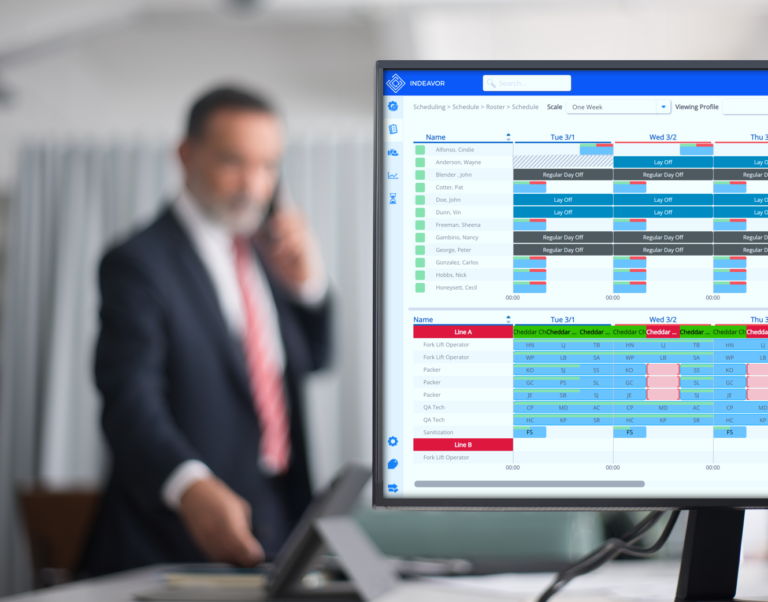Introduction
To describe what The People Operations Platform is, we must first define a few other things. First, there needs to be an understanding of workforce management and how this technology category misses a few critical areas in operations.
The need for greater visibility and automation via intuitive technology has never been greater. The industrial enterprise—traditionally manufacturing, supply chain, oil and gas, energy, and government agencies—has been the slowest to adapt to smart technology. Budget-focused enterprises are identifying gaps in operations technology and prioritizing solutions in this area. So, let’s get started with a breakdown of technology options today, and how The People Operations Platform fills Enterprise technology gaps.
What is Workforce Management?
The term “workforce management” on its own is nebulous. When many professionals hear this, they often associate the technology with horizontal solutions within human resources. Traditional workforce management solutions have not been verticalized to focus on the unique needs of an incredibly complex workforce with 24/7 environments and endless certifications to consider during the scheduling process.
These solutions don’t possess the capacity to drill down into deep detail which are used for advanced planning, scheduling, and engagement algorithms. Traditional workforce management solutions are human resource-focused. They graze the grounds of time and attendance and payroll support. Additionally, they lack the lack of focus on operations with planning automation via integration into Enterprise Resource Planning systems. This leaves much to be desired by operations professionals at industrial organizations.
The Need for More in a Connected Factory
The industrial workforce is the backbone of our everyday life. Every experience we enjoy is provided by industrial workers. From food and beverage manufacturers to oil refineries and nuclear energy plants, our world operates because of these critical frontline people.
Cost Control
These industries continue to experience a decline in employment rates and have so for the past 40 years. Employment struggles and supply chain issues matched with increased demand are fueling inflation. Take this information about the impacts of the industrial enterprise and our supply chain, for example, from a recent NPR interview with Donald Kohn, former Vice Chair of the Fed’s Board of Governors:
“There are high inflation and very strong demands from people for goods and services, causing that inflation much stronger than can be produced by the available labor force. So, people are bidding against each other for the goods and services, for the stuff they want to buy. The labor force can’t produce it. People are bidding for the workers to produce it. That’s driving up wages. So, we’ve got prices and wages going up. The Fed – the rock and the hard place is the Fed wants to damp down that demand for goods and services, but not so far as to cause people to be unemployed. So, they want to keep the labor market going well.”
With many variables impacting inflation, the pressure to control the cost of products and goods is more eminent than ever, putting pressure on labor optimization and smarter workflows.
Attracting and Retaining Skilled Workers
Per Reuters, the May 2022 Job Openings and Labor Turnover Survey, or JOLTS report, from the Labor Department show layoffs at a record low, underscoring the jobs market tightness. Growth in the industry paired with demand to fill vacancies is driving industrial organizations to uncover new ways to attract and retain skilled workers. According to the Reuters report, “transportation, warehousing, and utilities sector had an additional 97,000 unfilled jobs. Job openings increased by 67,000 in nondurable goods manufacturing, while makers of long-lasting goods had 53,000 more vacancies.”
“All of the six biggest manufacturing industries including machinery and transportation equipment reported moderate-to-strong growth. Manufacturing remains constrained by snarled supply chains, which have been further entangled by Russia’s unprovoked war against Ukraine and new shutdowns in China as part of Beijing’s zero COVID-19 policy.”
The costs of maintaining an employee are far less than the costs of recruiting and training new employees, so industrial enterprises are prioritizing employee engagement initiatives and putting the worker’s needs back into focus as a priority in enterprise operations.
Safety
A safe facility is a profitable facility and eliminating violation fees/worker injury boosts the bottom line. When individuals feel as though their employer cares about their well-being, they are much more willing to go above and beyond for that company. A focus on safety goes a long way toward making manufacturing a more attractive career choice while ensuring employees remain healthy and able to work. OSHA violations and fines can get out of control quickly, such as Fatigue Management regulations in the nuclear industry that average $300,000 per violation. Fatigue Management and promoting worker safety at the point of scheduling is an operational goal that industrial organizations across the globe continue to aim for.

What is a People Operations Platform?
An intelligent system that fills the gaps between siloed enterprise systems (HCM, ERP, Payroll, and LMS) with one industrial operations ecosystem interface. Plan, schedule, manage and engage your frontline workers.
A People Operations Platform is…
-
- Purpose-built for environments that never rest
-
- People-focused to meet your employee’s needs
-
- Rules-driven for specific industry regulations and complex environments
-
- Labor-aligned to save time and money wasted on unplanned labor expenses
-
- Data-proven visibility for better shift scheduling decisions
-
- Production-fixated to meet changing demands in your ERP
-
- Custom-engineered for your specific language and roster
-
- Expert-supported for the entirety of our relationship
-
- Scalable to reach international facilities
A People Operations Platform is NOT…
-
- A stand-alone solution
-
- An off-the-shelf product
-
- A simple reporting tool
-
- A data dump to set and forget
-
- A set of basic scheduling algorithms
-
- A one-size-fits-all employee scheduling system
-
- Designed for general audiences or the static workforce
Stakeholders in the Factory of the Future
The factory of the future is a connected enterprise. Technology promotes quality and automation to control costs and provide the visibility needed for actionable improvements from the executive’s desk to the factory floor. The following are key stakeholders in People Operations in the Industrial Enterprise:
Executive Leadership: Executives at industrial organizations often ask, “How do I make sure we are empowering our workforce and improving productivity, alignment, and visibility?” A People Operations Platform provides a better way to track and measure operational environments.
With Indeavor, key stakeholders can access data visibility from the enterprise level to the factory floor. All your questions about labor optimization and workforce management are answered with labor alignment analytics and automated reports.
Technology and Digital Innovation: Digital Innovators and IT Leaders are constantly brainstorming new ways to update outdated processes with technology. These folks often ask, “How do we digitally enable our operating environment and integrate with existing solutions to fill our workforce management technology gaps?” They need a way to eliminate paper processes and human error to get reliable insights. Without digital workflows, organizations often experience the People Operations Void. By connecting existing enterprise systems to leverage integrated workforce information, The People Operations Platform allows their industrial enterprise to make better decisions, faster.
Administration and Operations: Administrators, Schedulers, and Operations professionals require new technology to fill the gaps in their technology ecosystem. They may be asking, “How can we create a centralized operational hub to provide visibility and flexibility for our unique operations?” They need a way to get better control over operational goals with centralized visibility, compliance, and labor rules in one strategic people operations platform. With the People Operations Platform, Administrators and Operations professionals will be able to align and control variable labor costs within their daily operations.
Frontline: Frontline Managers and Supervisors need more autonomy in their roles and may be asking, “How can I achieve productivity through safety and efficiently deploying my workforce?” They need a way to ensure the safety of their team and make scheduling assignments easier. The People Operations Platform eliminates the mental fatigue brought on by frequent schedule changes and streamlines front-line workflows through intelligent automation. Indeavor makes real-time scheduling adjustments and people’s decisions quick and easy.
End Users/Factory Workers: Arguably the most important role on the factory floor is the individual skilled workers. These tradespeople are often open to other career options and often feel like ‘just a number’ in the enterprise. With a focus on the most competitive labor market in ages, engaging these valuable individuals is critical. Skilled workers are likely asking themselves, “How can I get better work-life flexibility and control?” The People Operations Platform provides a better way to access work schedules and request changes. With Indeavor Engage, The People Operations Platform’s mobile shift schedule application, skilled workers obtain ultimate schedule flexibility and visibility with modern technology. Indeavor Engage allows people to request leave, volunteer, swap shifts, and schedule advanced vacations from the convenience of their smartphone in the palm of their hand.
Conclusion
The need for greater visibility and automation via intuitive technology has never been greater as staffing, supply chain, and inflation issues continue to persist. Industrial enterprises— those traditionally in manufacturing, supply chain, oil and gas, energy, and government agencies have been the slowest to adapt to smart technology. Budget-focused enterprises are identifying gaps in operations technology and prioritizing solutions in this area. Our purpose-built People Operations Platform fills technology gaps for Industrial Enterprises.







